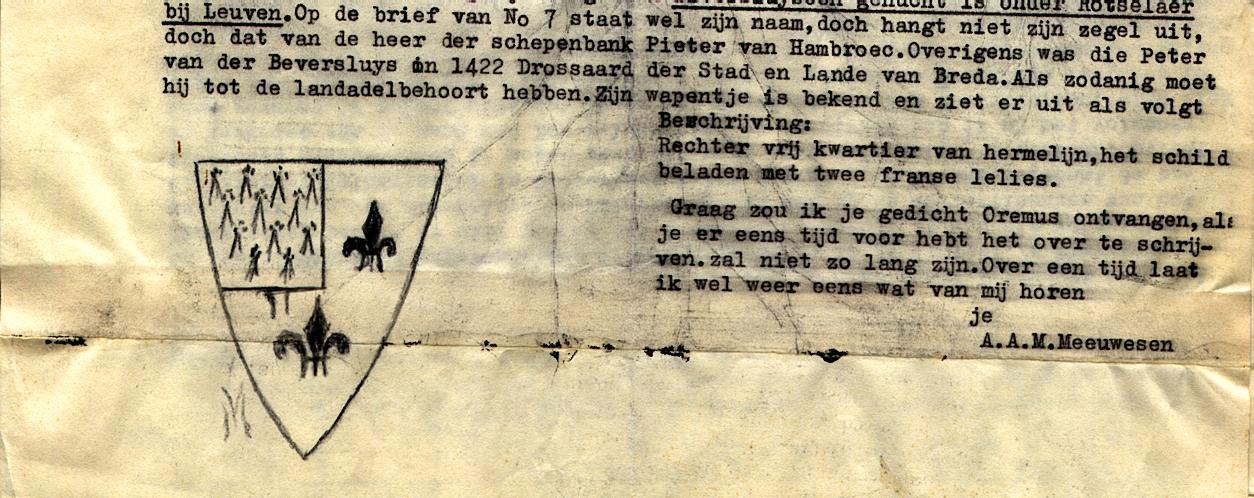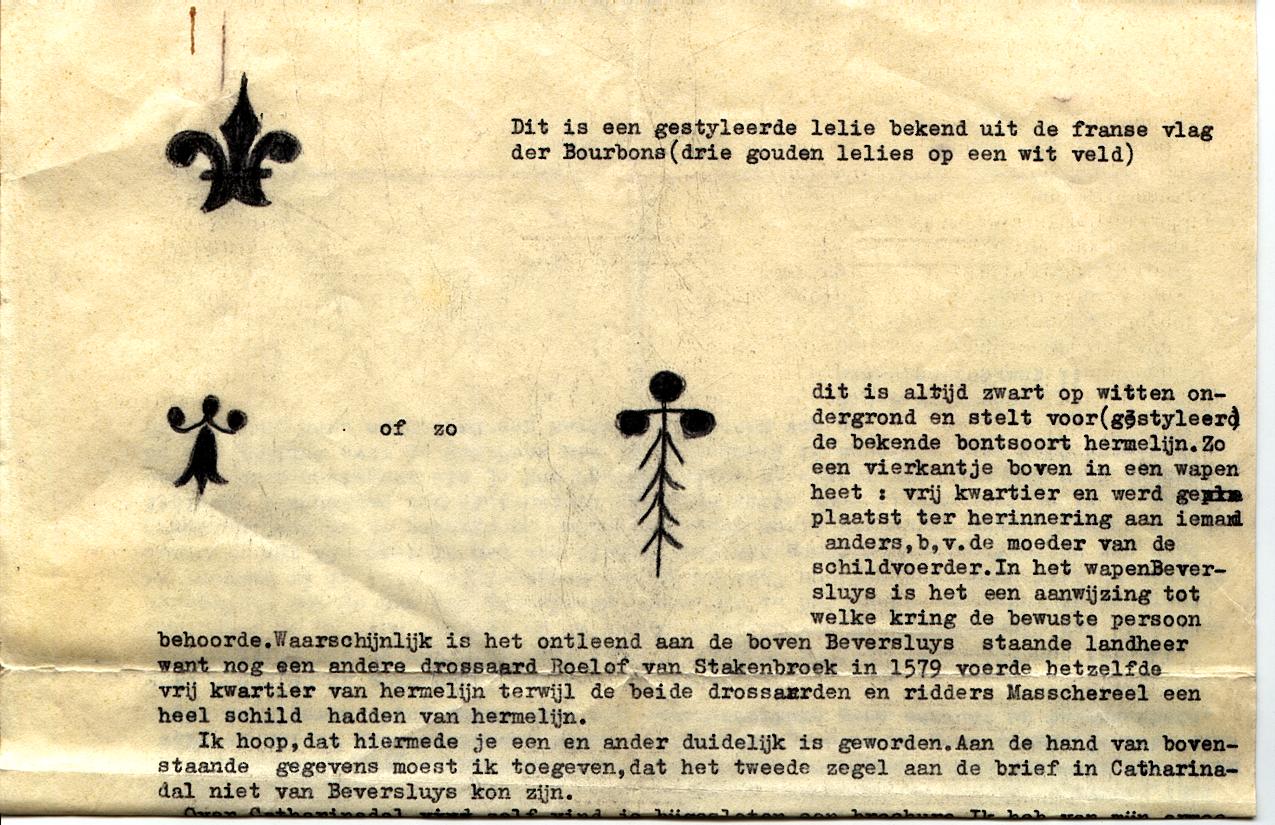Origin; family name, members, titles...According to A.A.M. Meeuwesen (as set out in a letter dated
May 9th. 1947):In the vicinity of Breda, specifically Terheyden (also called
Hertele or Schimmeren), he found quite a few members of the
family van der Beversluys.In Princenhage were, next to the "schepenbank" van de Heer
van Breda, a number of lesser "schepenbanken", belonging to
"leengoederen" in the area. It is quite unusual for such a small
place to have that many "schepenbanken".One of the schepenbanken belonged to Peter van Hambroec
(called a Knight and owner of "De Heerlijkheid Hambroec en
Gagelden" near Princenhage) and one of the seven "schepenen"
was Peter van der Beversluys.A document with his name - dated 1407 - and two seals, is kept
in the Breda convent "Catharinadal" (located in Oosterhout).
One seal was from Peter van Hambrouc, the other one did *not*
belong to Peter van der Beversluys. However, his "wapen" (or
shield?) is known (see scan).


In the year 1422 Peter van der Beversluys was "Drossaard der
Stad en Lande" of Breda, making him part of the "landadel". In
a book - by "Van Goor" - Title: Beschijving van Stad en Lande
van Breda 1736 his shield or "wapen" is depicted.Lexicon:
Adel = nobility, gentry, noble
Heerlijkheid = (bliss); feudal land
Leenheer = feudal lord, liege lord
Leenman = vassal, liege man
Landadel = feudal nobilitySchout = sheriff, bailiff.
Schepen = sheriff.
Schepenbank = sheriff's courtIn the middle ages a Duke was ruler over an independent
"kingdom" (or Dukedom).These in turn were divided into Ambten and parceled out to
loyal vassals (for good services, for instance). An Ambt was
ruled by a Leenman, called a Drossaard and as such he had
plenipotentiary powers in his Ambt. His representative was
the Lieutenant-Drossaard. An Ambt (or city) had it's own
militia; de Schutterij.An Ambt was then further divided into (administrative) area's,
ruled by the Schepenbanken.("Aan het hoofd van het ambt stond de drossaard, de edelman
die zich voor de uitoefening van zijn functie liet vervangen door
de luitenant-drossaard. Hij bezat uitgebreide macht op militair,
bestuurlijk en gerechtelijk vlak.)Rumors & legends:
One rumor has it that the family originated from around Rijssel
(Lille, France).Another rumor is that one of our ancestors was "Kamerheer"
(chamberlain) to Prins Willem van Oranje. Note: Prins Willem
van Oranje is the "founding father" of the present Dutch Royal
Family... The Prince was murdered in Delft in 1584.
"Op dinsdag 10-07-1584 wordt "Vader des Vaderlands" Prins
Willem van Oranje-Nassau in den Prinsenhof te Delft
doodgeschoten door Balthasar Gerards."Another story about the origins of the family is that 3 brothers
- fleeing the Southern Netherlands, being Huegenots and as such
persecuted - settled themselves in Klundert. It is unclear what
names they had before the flight or if they changed it at all.
There is another possibility: that the Beversluijs family - as is
the case with a number of prominent families - came north from
South Brabant, with their liege lord. That might have been around
1250 AD, with Arnout van Leuven, who became Heer van Breda
by marriage. It may also have been sometime later (1350) with
Machteld van Rotselaer, second wife to Jan I van Polanen,
Heer van Breda.It is worth noting that Beversluys is a hamlet, part of Rotselaer,
(near Leuven)!Note on Prins Willem van Oranje:
"Het ontstaan van het vorstenhuis. De naam Nassau is ontleend
aan de burcht Nassau, die begin twaalfde eeuw werd gebouwd in
een gebied dat nu behoort tot de Duitse deelstaat Hessen. De
band tussen Nederland en Nassau ontstond in 1403, toen graaf
Engelbert I van Nassau met Johanna van Polanen trouwde.(De eigendomsrechten van de Heerlijkheid Breda zelf verkocht
de hertog in 1350 aan Willem's neef, Jan van Polanen. Na de
dood van Willem van Duivenvoorde in 1353 kwam de heerlijkheid
in het volle genot van Jan van Polanen. Het was ten slotte de
kleindochter van Jan van Polanen, Johanna, die door haar
huwelijk met Engelbrecht van Nassau in 1404 Stad en Land van
Breda in het Nassause huis overbracht. Met dit huwelijk begon
de feitelijke opkomst van dit Duitse geslacht in de Nederlanden.)Vanaf dat moment behoorde deze tak van de Nassaus tot de
belangrijkste adelijke families van Nederland.Een van de afstammelingen van Engelbert, René van Chalon,
bezat naast wat huisjes en landerijen in Nederland ook een
aardig optrekje met wat grond in het zelfstandige prinsdom
Orange in Zuid Frankrijk. De daaraan verbonden titel Prins
van Oranje was erfelijk. Dat kwam goed uit voor zijn neef
Willem van Nassau, die toen René dood ging (in 1544) zich
Prins Willem van Oranje ging noemen. Daarvoor was hij
namelijk nooit verder dan graaf gekomen.Deze Willem, geboren in 1533 in het Duitse stadje Dillenburg,
werd mede door zijn strijd tegen de Spaanse onderdrukking,
een legendarische figuur in de Nederlandse geschiedenis.
Hij verwierf de eretitel Vader des Vaderlands. Zijn naam leeft
dan ook voort in het volkslied, het Wilhelmus.(There is a link between de families "van Nassau" (the Royal
Family), "van Polanen" and "Rotselaer". Somehow the family
Beversluys just might be tied in also.
Notes:In the age of Internet some old archives are accessible, others
will be made accessible in the future. As it happens the old
DTB-archives (Doop, Trouw, Begraaf boeken = baptism, wedding
and burrial registers) of Breda and surroundings can be - partly -
accessed. Church records go back a long time and are the most
useful and trustworthy source of information of that time.The passages I found are in Latin (and contain short notes for
dedications of Mass, I think, mostly for a deceased person).Beversluys, de
Aleyde, vrouwe
[AKAPB419] 1493-09-22
[AKAPB419] Domicellae Aleydis de Beversluys 1 vertel
rogs 1493 Z
[AKANB0682] 1493-09-22
[AKANB0682] Obitus domicelle Aleydis de Beversluys
2 fertellos siliginis mediatim anno 1493 capitulo 10 st. et
tabulam ligneam sculptam ymaginibus in altare super ocsale
//rogge: 4Elizabeth de Beversluys, echtgenote van Johannes de Nederven,
vrouwe, zie NedervenJohannes
[CKAPB259] 1459-04-21
[CKAPB259] Johannis de Beversluys ½ florenum arnoldi
anno 1459 // den.: 26 m.: 2
[AKAPB153] 1458-04-21
[AKAPB153] Johannis de Beversluys 5 st. 1458 // den.: 26 m.: 2
[AKANB0249] 1459-04-21
[AKANB0249] Obitus Johannes van der Beversluys
capitulo 7,5 gr. veteres capellanis 5 st. et curato 2 st.
anno 1459// ort: 53Katherina de Beversluys, echtgenote van Johannes de Holten,
zie HultenClara, echtgenote van Johannes Beversluys
[AKAPB264] 1459-06-28
[AKAPB264] Domicellae Clarae uxoris Johannis Beversluys
½ florenum arnoldi 1459 // den.: 26 m.: 2
[AKANB0425] 1459-06-28
[AKANB0425] Obitus domicelle Clare uxoris
Johannis van der Beversluys 7,5 gr. veteres capellanis cum
curato 5 st. Anno 1459// ort: 53Margareta, vrouwe
[AKAPB065] 1484-02-20
AKAPB065] Domicellae Margaretae de Beversluys
1 vertel rogs 1484 Z
[AKANB0104] 1483-02-20
[AKANB0104] Obitus domicelle Margarete de Beversluys
halstarium siliginis mediatim anno 1483 //rogge: 4Maria Clara
[CKAPB443] 1459-06-29
[CKAPB443] Commemoratio domicelle Marie Clare
de Beversluys ½ florenum arnoldi anno 1459 // den.: 26 m.: 2Several - but not all - of the women are titled "Vrouwe", meaning
Lady. It is further indication that the Beversluys family at the
time was of some considerable importance.Note the inaccuracies in the names: Johannis (2x) Johannes (2x)
De Beversluys or Van Der Beversluys. It is worth to remember
that these things occur, because the name changed, or because
what is written in the old registers is hard to read & decypher.
Last updated: 29-09-2002.